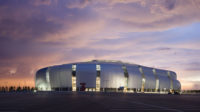The amount of attention showered on Manhattan’s 425 Park Avenue, the proposed 687-foot-high office tower by Foster + Partners, may make people wonder. A very high high-rise—this is what New York City does, so why the fuss? The reasons would seem to be disparate but compelling: the first three of course are location, location, location. The skyscraper, which was announced October 3, will occupy a block between 55th and 56th Streets, a stretch of Park Avenue that is famous for two Modernist landmarks—Mies van der Rohe’s Seagram Building (1958) and Skidmore, Owings & Merrill’s Lever House (1952).
Add to the location the fact that little new construction has appeared in this swank section of East Midtown since the 1950s. And making the project even more newsworthy is the choice of the architect, the world-renown Norman Foster. Since the developer, L&L Holding Company, is a not-so-famous firm founded in 2000 by David Levinson and Robert Lapidus—heretofore best known for renovating 200 Fifth Avenue—of course New York’s architecture, planning, and building communities are intrigued. (Also intriguing is L&L’s partner, Lehman Brothers Holdings, which only recently came out of bankruptcy from its role in the financial crisis four years ago.)
Put all this together with the timing of its appearance. The tower is being proposed at a moment when Mayor Bloomberg is pushing for the rezoning of a 70-block area around Grand Central (between 39th and 57th Streets). The East Midtown zoning would change the Floor Area Ratio (FAR) as of right for buildings from 15 to 24 around the (“core”) terminal area, and 2l.6 FAR on certain sites up the avenue.
All these factors might explain why a substantial audience showed up at Jazz at Lincoln Center in the Time Warner building on October 19 to see Foster present his firm’s scheme for 425 Park at the Municipal Art Society (MAS) Summit 2012. The tall, attenuated, elegant skyscraper is a far cry from Foster’s stubby, muscular Hearst Tower (2006) in west Midtown. It is a significantly better design than the 32-story wedding-cake shaped building by Kahn & Jacobs it will replace on Park Avenue. L&L Holding will take over the lease of the site when the original one expires for the 1957 structure (along with current occupants’ leases) in 2015. L&L then plans to demolish the white-brick and glass pile for the new scheme.
Foster’s 41-story tower pushes the elevator core to the rear (east) elevation, articulated by three shear walls. The glass and steel frame structure provides column-free spaces and views on three sides. Setbacks allow large open spaces or terraces for the 650,000-square-foot (gross) high-rise. If zoning allows, the tower will be lifted off the street to create a large sheltered plaza, which Levinson and Foster consider intrinsic to improving the public realm.
Foster’s tower won out over three other schemes by L&L’s short list of architects—OMA, Rogers Stirk Harbour & Partners, and Zaha Hadid Architects— following an intense selection process.
Incidentally, the head honchos of each firm showed up for design presentations in July—Richard Rogers, Norman Foster, Zaha Hadid, and Rem Koolhaas. “It was a very unusual competition,” Foster says. “The developers were very interested in learning about how it would be to work with the architects.” They did so through visits to the short-listed architects’ offices in addition to the presentation and a number of smaller meetings.
Levinson obviously was looking for an architect experienced with office towers. Nevertheless the fact that three of the short listed firms are based primarily in London, while the fourth, OMA, is in Rotterdam, naturally raises the question why there are no American firms. Levinson told RECORD: “There is great architecture in the world, but it’s not happening in the U.S. Our country is not leading in this building type.”
In order to fully vet the architects in terms of their ability to address the city’s real-politik issues, Levinson brought in Vishaan Chakrabarti, a former city planner, and a past executive with Related Companies who is currently director of the Center for Urban Real Estate at Columbia University and a principal of SHoP. The two enlisted a selection advisory committee that represents civic, real estate, and governmental perspectives: Vin Cipolla, President of the MAS (of which Levinson is a board member); Mary Ann Tighe, who is CEO of the New York Tri-State region for the high-stakes real estate firm CBRE, and outgoing chair of the Real Estate Board of New York (as well as a staunch advocate of higher skyscrapers in the city); and Jennifer Raab, president of Hunter College and former chair of the New York City Landmarks Preservation Commission.
Now that L&L now has a viable, seductive scheme, it must next deal with the sticky wicket of zoning. While the Kahn & Jacobs office block is built to an FAR of 18, land in the area is currently zoned at a 15 FAR. Indeed, the bulky 1957 tower, 370-feet high, has an 18 FAR by happenstance: the building was finished before the FAR formula was introduced into the 1961 zoning law. The city's zoning currently allows Levinson to keep the existing building’s 18 FAR, if he retains 25 percent of the original floor area, which means that a Foster tower would be built over six floors of Kahn & Jacobs’ steel base. Levinson and Foster prefer a new from-the-ground-up version that would add light and air to the street level.



Post a comment to this article
Report Abusive Comment